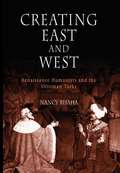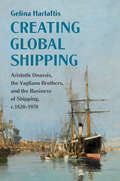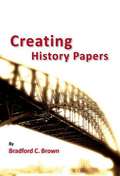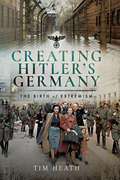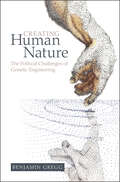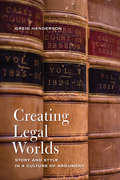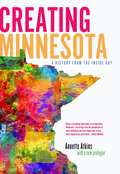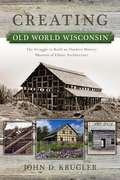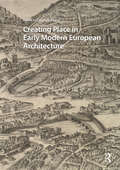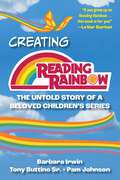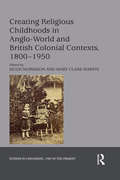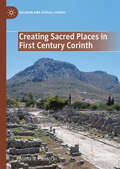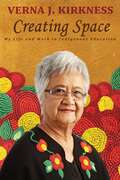- Table View
- List View
Creating Democracy: Arendt and Bakhtin in Dialogue (Routledge Studies in Social and Political Thought)
by Charles HerschCreating Democracy brings into dialogue for the first time two important theorists of democracy: Hannah Arendt (1906–75) and Mikhail Bakhtin (1895–975). Their shared conception of democracy stemming from their encounters with totalitarian governments – Nazi Germany for Arendt and Stalinist Russia for Bakhtin – and the rise of authoritarian populism in both Europe and America make their ideas more relevant than ever.Charles Hersch contends that Arendt and Bakhtin have a unique vision of democracy that centers on creation and creativity. These two thinkers imagine a world that both makes room for the cultivation and expression of each person’s individuality and facilitates healthy interdependence, one that does not reduce us to sameness. They also describe the many threats to such a humanistic world, whether ideological, social, or political.Creating Democracy also makes a unique contribution to debates in political theory about the possibility of freedom in modern society. Offering an alternative to poststructuralism and liberalism, Arendt and Bakhtin show us how, in a variety of complex ways, subjects who are influenced by their culture, especially by the language in which they speak and think, can nonetheless help construct themselves and the world. For both thinkers, humans are meaning-making beings who shape the world, primarily through language, even as it shapes us. This book brings to light a rich vision of democracy that is sorely needed in a time when authoritarianism threatens us more than it has in decades. Students and scholars in political science, cultural studies, and literature will all find this book indispensable.
Creating Distinctions in Dutch Genre Painting: Repetition and Invention (Visual and Material Culture, 1300-1700)
by Angela HoIn the mid- to late seventeenth century, a number of Dutch painters created a new type of refined genre painting that was much admired by elite collectors. In this book, Angela Ho uses the examples of Gerrit Dou, Gerard ter Borch, and Frans van Mieris to show how this group of artists made creative use of repetition-such as crafting virtuosic, self-referential compositions around signature motifs, or engaging esteemed predecessors in a competitive dialogue through emulation-to project a distinctive artistic personality. The resulting paintings enabled purchasers and viewers to exercise their connoisseurial eye and claim membership in an exclusive circle of sophisticated enthusiasts-making creative repetition a successful strategy for both artists and viewers.|Angela Ho shows how Dutch painters in the mid- to late 17th century used repetition to project a distinctive artistic personality.
Creating East and West
by Nancy BisahaAs the Ottoman Empire advanced westward from the fourteenth to the sixteenth centuries, humanists responded on a grand scale, leaving behind a large body of fascinating yet understudied works. These compositions included Crusade orations and histories; ethnographic, historical, and religious studies of the Turks; epic poetry; and even tracts on converting the Turks to Christianity. Most scholars have seen this vast literature as atypical of Renaissance humanism. Nancy Bisaha now offers an in-depth look at the body of Renaissance humanist works that focus not on classical or contemporary Italian subjects but on the Ottoman Empire, Islam, and the Crusades. Throughout, Bisaha probes these texts to reveal the significant role Renaissance writers played in shaping Western views of self and other.Medieval concepts of Islam were generally informed and constrained by religious attitudes and rhetoric in which Muslims were depicted as enemies of the faith. While humanist thinkers of the Renaissance did not move entirely beyond this stance, Creating East and West argues that their understanding was considerably more complex, in that it addressed secular and cultural issues, marking a watershed between the medieval and modern. Taking a close look at a number of texts, Bisaha expands current notions of Renaissance humanism and of the history of cross-cultural perceptions. Engaging both traditional methods of intellectual history and more recent methods of cross-cultural studies, she demonstrates that modern attitudes of Western societies toward other cultures emerged not during the later period of expansion and domination but rather as a defensive intellectual reaction to a sophisticated and threatening power to the East.
Creating German Communism, 1890-1990: From Popular Protests to Socialist State
by Eric D. WeitzEric Weitz presents a social and political history of German communism from its beginnings at the end of the nineteenth century to the collapse of the German Democratic Republic in 1990. In the first book in English or in German to explore this entire period, Weitz describes the emergence of the Communist Party of Germany (KPD) against the background of Imperial and Weimar Germany, and clearly explains how the legacy of these periods shaped the character of the GDR to the very end of its existence. In Weimar Germany, social democrats and Germany's old elites tried frantically to discipline a disordered society. Their strategies drove communists out of the workplace and into the streets, where the party gathered supporters in confrontations with the police, fascist organizations, and even socialists and employed workers. In the streets the party forged a politics of display and spectacle, which encouraged ideological pronouncements and harsh physical engagements rather than the mediation of practical political issues. Male physical prowess came to be venerated as the ultimate revolutionary quality. The KPD's gendered political culture then contributed to the intransigence that characterized the German Democratic Republic throughout its history. The communist leaders of the GDR remained imprisoned in policies forged in the Weimar Republic and became tragically removed from the desires and interests of their own populace.
Creating Global Shipping: Aristotle Onassis, the Vagliano Brothers, and the Business of Shipping, c.1820–1970 (Cambridge Studies in the Emergence of Global Enterprise)
by Gelina HarlaftisShipping has been the international business par excellence in many national economies, one that preceded trends in other, more highly visible sectors of international economic activity. Nevertheless, in both business or economic history, shipping has remained relatively overlooked. That gap is filled by this exploration of the evolution of European shipping through the study of two Greek shipping firms. They provide a prime example of the regional European maritime businesses that evolved to serve Europe's international trade and, eventually, the global economy. By the end of the twentieth century, Greeks owned more ships than any other nationality. The story of the Vagliano brothers traces the transformation of Greek shipping from local shipping and trading to international shipping and ship management, while the case of Aristotle Onassis reveals how international shipping was transformed into a global business.
Creating History Papers (Students And Professional Concerns)
by Bradford BrownThis reference guide is a must-read for all history students that addresses the howsof history papers, and presents technical information to aid in the process of researching, writing, and documenting.
Creating Hitler's Germany: The Birth of Extremism
by Tim HeathA historian seeks to answer &“What created Hitler&’s Germany?&” by examining personal stories and first-hand accounts of post-World War I German families. Germany&’s defeat in the First World War and the Treaty of Versailles that followed were national disasters, with far-reaching consequences not just for the country but for the world itself. Weaving the stories of three German families from the beginning of Germany&’s territorial aspirations of the First World War to the shattered dream of a thousand-year Reich in the Second World War, Tim Heath&’s rich narrative explores a multitude of rare and untapped resources to explore the darkest recesses of German social and military history. Creating Hitler&’s Germany presents a nation&’s journey not only through everyday life and war, but through its own conscience, pain, and inevitable search for some form of absolution from its past. It is real, painful, and incredibly human—an essential history to further understand the mind-set of Germany during the most tumultuous years of the nation&’s history.
Creating Human Nature: The Political Challenges of Genetic Engineering
by Benjamin GreggHuman genetic enhancement, examined from the standpoint of the new field of political bioethics, displaces the age-old question of truth: What is human nature? This book displaces that question with another: What kind of human nature should humans want to create for themselves? To answer that question, this book answers two others: What constraints should limit the applications of rapidly developing biotechnologies? What could possibly form the basis for corresponding public policy in a democratic society? Benjamin Gregg focuses on the distinctly political dimensions of human nature, where politics refers to competition among competing values on which to base public policy, legislation, and political culture. This book offers citizens of democratic communities a broad perspective on how they together might best approach urgent questions of how to deal with the socially and morally challenging potential for human genetic engineering.
Creating Jazz Counterpoint: New Orleans, Barbershop Harmony, and the Blues (American Made Music Series)
by Vic HobsonThe book Jazzmen (1939) claimed New Orleans as the birthplace of jazz and introduced the legend of Buddy Bolden as the "First Man of Jazz." Much of the information that the book relied on came from a highly controversial source: Bunk Johnson. He claimed to have played with Bolden and that together they had pioneered jazz. Johnson made many recordings talking about and playing the music of the Bolden era. These recordings have been treated with skepticism because of doubts about Johnson's credibility. Using oral histories, the Jazzmen interview notes, and unpublished archive material, this book confirms that Bunk Johnson did play with Bolden. This confirmation, in turn, has profound implications for Johnson's recorded legacy in describing the music of the early years of New Orleans jazz. New Orleans jazz was different from ragtime in a number of ways. It was a music that was collectively improvised, and it carried a new tonality--the tonality of the blues. How early jazz musicians improvised together and how the blues became a part of jazz has until now been a mystery. Part of the reason New Orleans jazz developed as it did is that all the prominent jazz pioneers, including Buddy Bolden, Bunk Johnson, Louis Armstrong, Sidney Bechet, Johnny Dodds, and Kid Ory, sang in barbershop (or barroom) quartets. This book describes in both historical and musical terms how the practices of quartet singing were converted to the instruments of a jazz band, and how this, in turn, produced collectively improvised, blues-inflected jazz, that unique sound of New Orleans.
Creating Judaism: History, Tradition, Practice
by Michael SatlowHow can we define "Judaism," and what are the common threads uniting ancient rabbis, Maimonides, the authors of the Zohar, and modern secular Jews in Israel? Michael L. Satlow offers a fresh perspective on Judaism that recognizes both its similarities and its immense diversity. Presenting snapshots of Judaism from around the globe and throughout history, Satlow explores the links between vastly different communities and their Jewish traditions. He studies the geonim, rabbinical scholars who lived in Iraq from the ninth to twelfth centuries; the intellectual flourishing of Jews in medieval Spain; how the Hasidim of nineteenth-century Eastern Europe confronted modernity; and the post-World War II development of distinct American and Israeli Jewish identities. Satlow pays close attention to how communities define themselves, their relationship to biblical and rabbinic texts, and their ritual practices. His fascinating portraits reveal the amazingly creative ways Jews have adapted over time to social and political challenges and continue to remain a "Jewish family."
Creating Kashubia: History, Memory, and Identity in Canada's First Polish Community
by Joshua C. BlankIn recent years, over one million Canadians have claimed Polish heritage - a significant population increase since the first group of Poles came from Prussian-occupied Poland and settled in Wilno, Ontario, west of Ottawa in 1858. For over a century, descendants from this community thought of themselves as Polish, but this began to change in the 1980s due to the work of a descendant priest who emphasized the community’s origins in Poland’s Kashubia region. What resulted was the reinvention of ethnicity concurrent with a similar movement in northern Poland. Creating Kashubia chronicles more than one hundred and fifty years of history, identity, and memory and challenges the historiography of migration and settlement in the region. For decades, authors from outside Wilno, as well as community insiders, have written histories without using the other’s stores of knowledge. Joshua Blank combines primary archival material and oral history with national narratives and a rich secondary literature to reimagine the period. He examines the socio-political and religious forces in Prussia, delves into the world of emigrant recruitment, and analyzes the trans-Atlantic voyage. In doing so, Blank challenges old narratives and traces the refashioning of the community’s ethnic identity from Polish to Kashubian. An illuminating study, Creating Kashubia shows how changing identities and the politics of ethnic memory are locally situated yet transnationally influenced.
Creating Kashubia: History, Memory, and Identity in Canada's First Polish Community (McGill-Queen's Studies in Ethnic History #110)
by Joshua BlankA groundbreaking work that looks at the changing ways in which Canada&’s first Polish community views itself.
Creating Kosovo: International Oversight and the Making of Ethical Institutions
by Elton SkendajIn shaping the institutions of a new country, what interventions from international actors lead to success and failure? Elton Skendaj's investigation into Kosovo, based on national survey data, interviews, and focus groups conducted over ten months of fieldwork, leads to some surprising answers. Creating Kosovo highlights efforts to build the police force, the central government, courts, and a customs service. Skendaj finds that central administration and the courts, which had been developed under local authority, succumbed to cronyism and corruption, challenging the premise that local "ownership" leads to more effective state bureaucracies. The police force and customs service, directly managed by international actors, were held to a meritocratic standard, fulfilling their missions and winning public respect. On the other hand, local participation and contestation supported democratic institutions. When international actors supported the demobilization of popular movements, Creating Kosovo shows, they undermined the ability of the public to hold elected officials accountable.
Creating Legal Worlds
by Greig HendersonA legal judgment is first and foremost a story, a narrative of facts about the parties to the case. Creating Legal Worlds is a study of how that narrative operates, and how rhetoric, story, and style function as integral elements of any legal argument.Through careful analyses of notable cases from Canada, the United States, and the United Kingdom, Greig Henderson analyses how the rhetoric of storytelling often carries as much argumentative weight within a judgement as the logic of legal distinctions. Through their narrative choices, Henderson argues, judges create a normative universe - the world of right and wrong within which they make their judgements - and fashion their own judicial self-images. Drawing on the work of the law and literature movement, Creating Legal Worlds is a convincing argument for paying close attention to the role of story and style in the creation of judicial decisions.
Creating Memory: Historical Fiction and the English Civil Wars (Critical Approaches to Children's Literature)
by Farah MendlesohnThis book considers the English Civil Wars and the civil wars in Scotland and Ireland through the lens of historical fiction—primarily fiction for the young. The text argues that the English Civil War lies at the heart of English and Irish political identities and considers how these identities have been shaped over the past three centuries in part by the children’s literature that has influenced the popular memory of the English Civil War. Examining nearly two hundred works of historical fiction, Farah Mendlesohn reveals the delicate interplay between fiction and history.
Creating Mental Illness
by Allan V. HorwitzIn this surprising book, Allan V. Horwitz argues that our current conceptions of mental illness as a disease fit only a small number of serious psychological conditions and that most conditions currently regarded as mental illness are cultural constructions, normal reactions to stressful social circumstances, or simply forms of deviant behavior.
Creating Mexican Consumer Culture in the Age of Porfirio Díaz
by Steven B. BunkerIn Gabriel García Márquez&’s novel One Hundred Years of Solitude, a character articulates the fascination goods, technology, and modernity held for many Latin Americans in the early twentieth century when he declares that &“incredible things are happening in this world.&” The modernity he marvels over is the new availability of cheap and useful goods. Steven Bunker&’s study shows how goods and consumption embodied modernity in the time of Porfirio Díaz, how they provided proof to Mexicans that &“incredible things are happening in this world.&”In urban areas, and especially Mexico City, being a consumer increasingly defined what it meant to be Mexican. In an effort to reconstruct everyday life in Porfirian Mexico, Bunker surveys the institutions and discourses of consumption and explores how individuals and groups used the goods, practices, and spaces of urban consumer culture to construct meaning and identities in the rapidly evolving social and physical landscape of the capital city and beyond. Through case studies of tobacco marketing, department stores, advertising, shoplifting, and a famous jewelry robbery and homicide, he provides a colorful walking tour of daily life in Porfirian Mexico City. Emphasizing the widespread participation in this consumer culture, Bunker&’s work overturns conventional wisdom that only the middle and upper classes participated in this culture.
Creating Minnesota: A History From The Inside Out
by Annette AtkinsRenowned historian Annette Atkins presents a fresh understanding of how a complex and modern Minnesota came into being in Creating Minnesota. Each chapter of this innovative state history focuses on a telling detail, a revealing incident, or a meaningful issue that illuminates a larger event, social trends, or politics during a period in our past. A three-act play about Minnesota's statehood vividly depicts the competing interests of Natives, traders, and politicians who lived in the same territory but moved in different worlds. Oranges are the focal point of a chapter about railroads and transportation: how did a St. Paul family manage to celebrate their 1898 Christmas with fruit that grew no closer that 1,500 miles from their home? A photo essay brings to life three communities of the 1920s, seen through the lenses of local and itinerant photographers. The much-sought state fish helps to explain the new Minnesota, where pan-fried walleye and walleye quesadillas coexist on the same north woods menu. In Creating Minnesota Atkins invites readers to experience the texture of people's lives through the decades, offering a fascinating and unparalleled approach to the history of our state.
Creating Old World Wisconsin
by John D. KruglerWith its charming heirloom gardens, historic livestock breeds, and faithfully recreated farmsteads and villages that span nearly 600 acres, Old World Wisconsin is the largest outdoor museum of rural life in the United States. But this seemingly time-frozen landscape of rustic outbuildings and rolling wooded hills did not effortlessly spring into existence, as John D. Krugler shows in Creating Old World Wisconsin. As dozens of historic buildings were transported in the 1970s from various locations throughout the state to the Kettle Moraine State Forest, researchers, curators, and volunteers launched a massive preservation initiative to salvage fast-disappearing immigrant and migrant architecture. They created a backdrop against which twenty-first-century interpreters demonstrate nineteenth- and early twentieth-century agricultural techniques and artisanal craftsmanship. The site, created and maintained by the Wisconsin Historical Society, offers visitors a unique opportunity to learn about the states rich and ethnically diverse past through depictions of the everyday lives of its Norwegian, Danish, Finnish, German, Polish, African American, and Yankee inhabitants. Creating Old World Wisconsin chronicles the fascinating and complex origins of this outdoor museum, highlighting the struggles that faced its creators as they worked to achieve their vision. Even as Milwaukee architect and preservationist Richard W. E. Perrin, the Societys staff, and enthusiastic volunteers opened the museum in time for the national bicentennial in 1976, the site was plagued by limited funds, bureaucratic tangles, and problems associated with gaining public support. By documenting the engaging story of the challenges, roadblocks, false starts, and achievements of the sites founders, Krugler brings to life the history of the dedicated corps who collected and preserved Wisconsins diverse social history and heritage.
Creating Place in Early Modern European Architecture (Visual and Material Culture, 1300-1700)
by Elizabeth MerrillThe importance of place – as a unique spatial identity – has been recognized since antiquity. Ancient references to the 'genius loci', or spirit of place, evoked not only the location of a distinct atmosphere or environment, but also the protection of this location, and implicitly, its making and construction. This volume examines the concept of place as it relates to architectural production and building knowledge in early modern Europe (1400-1800). The places explored in the book's ten essays take various forms, from an individual dwelling to a cohesive urban development to an extensive political territory. Within the scope of each study, the authors draw on primary source documents and original research to demonstrate the distinctive features of a given architectural place, and how these are related to a geographic location, social circumstances, and the contributions of individual practitioners. The essays underscore the distinct techniques, practices and organizational structures by which physical places were made in the early modern period.|An inquiry on place-making and architectural production in early modern Europe (1400-1750) Interdisciplinary methodology and critical approaches Thematic study that draws together subjects from throughout early modern Europe.
Creating Reading Rainbow: The Untold Story of a Beloved Children's Series
by Barbara Irwin Tony Buttino Sr. Pam JohnsonReading Rainbow is one of the most successful PBS children&’s series in television history, earning numerous national and international awards including 26 Emmys and a Peabody Award. But perhaps more important than anything else, Reading Rainbow helped generations of children cultivate a love for books.Reading Rainbow is very much a story of humble beginnings and enormous perseverance. Over five summers, Tony Buttino Sr. and his colleagues at WNED-TV, the public television station in Buffalo, New York, worked in collaboration with educators and librarians to experiment with summer reading programs. But after trialing these programs, the WNED team realized there was a big need for a new children's literacy series and believed they could create a new show with local and national collaborators and friends. After fits and starts, and enough twists and turns to fill a children&’s book, Reading Rainbow premiered in the summer of 1983 and captured the attention of 6.5 million young viewers. Creating Reading Rainbow explores the many intriguing and homespun stories that, when woven together, reveal how this groundbreaking and iconic television series came to be. What led to the series being called &“Reading Rainbow&”? How did the road to Reading Rainbow wind its way through Mister Rogers&’ Neighborhood? How did a public television station in Buffalo spearhead a movement in education and spark the passion for reading in millions of children? And, what does lasagna have to do with it?
Creating Religious Childhoods in Anglo-World and British Colonial Contexts, 1800-1950 (Studies in Childhood, 1700 to the Present)
by Hugh Morrison Mary Clare MartinDrawing on examples from British world expressions of Christianity, this collection further greater understanding of religion as a critical element of modern children’s and young people’s history. It builds on emerging scholarship that challenges the view that religion had a solely negative impact on nineteenth- and twentieth-century children, or that ‘secularization’ is the only lens to apply to childhood and religion. Putting forth the argument that religion was an abiding influence among British world children throughout the nineteenth and most of the twentieth centuries, this volume places ‘religion’ at the center of analysis and discussion. At the same time, it positions the religious factor within a broader social and cultural framework. The essays focus on the historical contexts in which religion was formative for children in various ‘British’ settings denoted as ‘Anglo’ or ‘colonial’ during the nineteenth and early- to mid-twentieth centuries. These contexts include mission fields, churches, families, Sunday schools, camps, schools and youth movements. Together they are treated as ‘sites’ in which religion contributed to identity formation, albeit in different ways relating to such factors as gender, race, disability and denomination. The contributors develop this subject for childhoods that were experienced largely, but not exclusively, outside the ‘metropole’, in a diversity of geographical settings. By extending the geographic range, even within the British world, it provides a more rounded perspective on children’s global engagement with religion.
Creating Romantic Obsession: Scorpions in the Mind (Palgrave Studies in Literature, Science and Medicine)
by Kathleen Béres RogersMost of us have, at one time, been obsessed with something, but how did obsession become a mental illness? This book examines literary, medical, and philosophical texts to argue that what we call obsession became a disease in the Romantic era and reflects the era’s anxieties. Using a number of literary texts, some well-known (like Mary Shelley’s 1818 Frankenstein and Edgar Allan Poe’s 1843 “The Tell Tale Heart”) and some not (like Charlotte Dacre’s 1811 The Passions and Charles Brockden Brown’s 1787 Edgar Huntly), the book looks at “vigilia”, an overly intense curiosity, “intellectual monomania”, an obsession with study, “nymphomania” and “erotomania”, gendered forms of desire, “revolutiana”, an obsession with sublime violence and military service, and “ideality,” an obsession with an idea. The coda argues that traces of these Romantic constructs can be seen in popular accounts of obsession today.
Creating Sacred Places in First Century Corinth (Religion and Spatial Studies)
by Alisha N. PaddockThis book applies spatial theories from human and cultural geography to the archaeological remains of Ancient Corinth in order to consider how sacred places could have been created in the first century. Building on Philip Sheldrake's theory, among others, the book defines sacred place as a space with significance. Significance is found in the group&’s spiritual history, their identity, and the proper behaviours required to keep the group remaining a group. The book further argues that if any of these elements of place are not recognized nor upheld, the group risks becoming placeless.
Creating Space: My Life and Work in Indigenous Education
by Verna J. KirknessVerna J. Kirkness grew up on the Fisher River Indian reserve in Manitoba. Her childhood dream to be a teacher set her on a lifelong journey in education as a teacher, counsellor, consultant, and professor. Her simple quest to teach "in a Native way" revolutionized Canadian education policy and practice. Kirkness broke new ground at every turn. As the first cross-cultural consultant for the Manitoba Department of Education Curriculum Branch she made Cree and Ojibway the languages of instruction in several Manitoba schools. In the early 1970s she became the first Education Director for the Manitoba Indian Brotherhood (now the Assembly of Manitoba Chiefs) and then Education Director for the National Indian Brotherhood (now the Assembly of First Nations). She played a pivotal role in developing the education sections of Wahbung: Our Tomorrows, which transformed Manitoba education, and the landmark 1972 national policy of Indian Control of Indian Education. These two major works have shaped First Nations education in Canada for more than 40 years. In the 1980s she became an assistant professor at the University of British Columbia where she was appointed Director of the Native Teacher Education Program, founded the Ts’‘Kel Graduate Program, and was a driving force behind the creation of the First Nations House of Learning. Honoured by community and country, Kirkness is a visionary who has inspired, and been inspired by, generations of students. Like a long conversation between friends, Creating Space reveals the challenges and misgivings, the burning questions, the successes and failures that have shaped the life of this extraordinary woman and the history of Aboriginal education in Canada.


